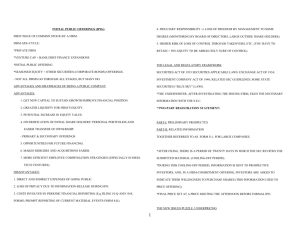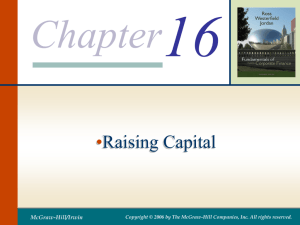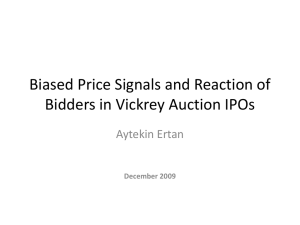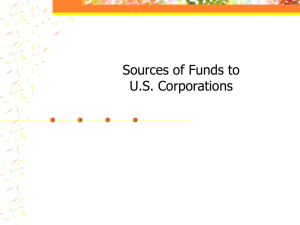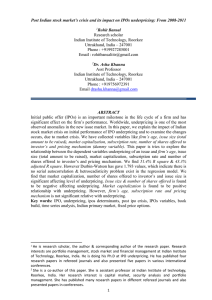IPO Underpricing: Auctions vs. Book Building ∗ Boyan Jovanovic and Balàzs Szentes
advertisement
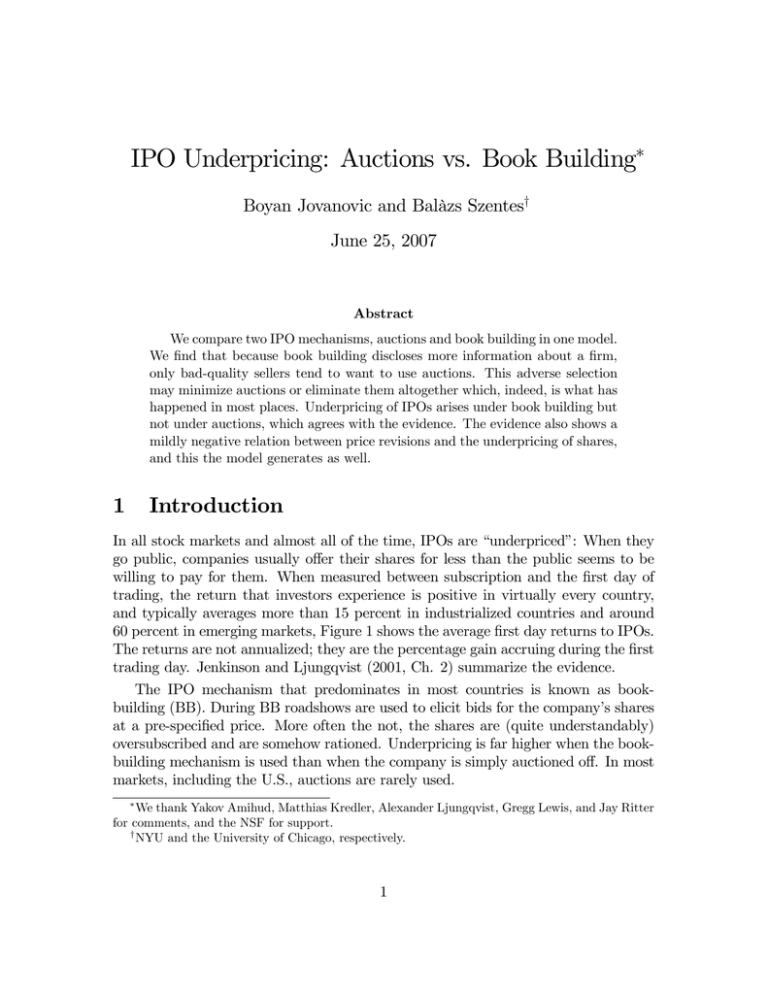
IPO Underpricing: Auctions vs. Book Building∗
Boyan Jovanovic and Balàzs Szentes†
June 25, 2007
Abstract
We compare two IPO mechanisms, auctions and book building in one model.
We find that because book building discloses more information about a firm,
only bad-quality sellers tend to want to use auctions. This adverse selection
may minimize auctions or eliminate them altogether which, indeed, is what has
happened in most places. Underpricing of IPOs arises under book building but
not under auctions, which agrees with the evidence. The evidence also shows a
mildly negative relation between price revisions and the underpricing of shares,
and this the model generates as well.
1
Introduction
In all stock markets and almost all of the time, IPOs are “underpriced”: When they
go public, companies usually offer their shares for less than the public seems to be
willing to pay for them. When measured between subscription and the first day of
trading, the return that investors experience is positive in virtually every country,
and typically averages more than 15 percent in industrialized countries and around
60 percent in emerging markets, Figure 1 shows the average first day returns to IPOs.
The returns are not annualized; they are the percentage gain accruing during the first
trading day. Jenkinson and Ljungqvist (2001, Ch. 2) summarize the evidence.
The IPO mechanism that predominates in most countries is known as bookbuilding (BB). During BB roadshows are used to elicit bids for the company’s shares
at a pre-specified price. More often the not, the shares are (quite understandably)
oversubscribed and are somehow rationed. Underpricing is far higher when the bookbuilding mechanism is used than when the company is simply auctioned off. In most
markets, including the U.S., auctions are rarely used.
∗
We thank Yakov Amihud, Matthias Kredler, Alexander Ljungqvist, Gregg Lewis, and Jay Ritter
for comments, and the NSF for support.
†
NYU and the University of Chicago, respectively.
1
First-day return
95
percent
Figure 1: Quarterly underpricing of IPOs in the U.S.: 1960-2003
It is often alleged that the underwriter of an IPO offers the shares and the supernormal returns to his favorite clients, ones with whom he deals with repeatedly, and
that this behavior is a part of a “trading favors” equilibrium in the game between the
underwriter and these clients. The losers, the story goes on, are the original owners
of the firm who could have gotten a better deal. Understanding IPO underpricing
therefore requires that we answer two questions:
1. How do the underwriter and his clients manage to collect such large rents from
the firm’s original owners and from its final owners?
2. Why do the firm’s original owners choose the BB mechanism and surrender
such seemingly large rents? Why don’t they simply auction the firm off and set
a reserve price?
To answer Question 1, we assume that the underwriter (i) has independent information about the market value of the firm, and (ii) has the bargaining power to
take advantage of that information. Assumption (i) is reasonable in that during BB
the underwriter’s analysts and accountants study the firm and its business prospects.
Assumption (ii) is best discussed after we see the details of the model, but the equilibrium outcome is that the underwriter extracts all the rents from the firms’s final
owners which is reasonable since there typically are many final owners. The firm’s
original owners manage to keep some, but certainly not all the rents.
As for Question 2, we argue that auctions are minimal or nonexistent because
the worst firms would choose the auction mechanism, and that this adverse selection
2
may eliminate auctions altogether. When the underwriter has information about the
firm, the BB process can effectively disclose that information to the final owners,
and then BB acts as a certification mechanism. This is true in equilibria in which
the underwriter’s behavior reveals some or all of his information. This is shown in
Section 5 where the basic model is extended to allow the auction option.
The model also generates failed IPOs; the empirical counterpart is withdrawn
IPOs that Dunbar (1998) has studied. It also has implications about share turnover,
or “flipping” that Loughran and Ritter (2007) study.
Our model differs from Benveniste and Spindt (1989) and similar models for two
reasons. First, underpricing arises not because of the need to elicit information from
the buyers, but because of the underwriter’s use his private information to capture the
rents for himself and for his favored clients.1 Second, the resulting surrender of rents
for the IPO-ing firm acts to keep the worst firms out of BB, and this adverse selection
can destroy the auction market altogether. Any auctions that remain entail less
underpricing than does BB. Our explanation contrasts with Jenkinson and Ljungqvist
(2001) who argue that since auctions do not generate as much information as BB does,
we expect that the easier-to-evaluate firms will choose auctions, not necessarily the
worst firms.
2
Model
We present the simplest version of the model here. What we estimate will have some
additions.
Logic of the model–The underwriter is supposed to be the agent for the original
owner of the firm, i.e., the firm’s prospective seller. Yet we shall follow principal-agent
theory and assume that the underwriter maximizes his own utility. The seller knows
his own value of keeping the object, but the buyer does not know his own value. The
BB process reveals information to the buyer
The game has 3 players: A buyer (B), a seller (S), and a middleman (M). Player
B is the prospective buyer and player S is the firm’s original owner, It is alleged that
the underwriter delivers cheap shares to his favored clients in return for their repeat
business and so on. We shall not model the relation between the underwriter and his
clients but, rather, lump all these agents into a single player that we call M.
Suppose that V ∼ F [v, v] and U ∼ G [u, u]. In addition 0 < v < u. The game
is the following: M gives a take-it-or-leave-it offer to S. The seller decides whether
to sell the object. If he does not sell the game ends. If he sells, M pays the price
and resells the objects to B. We assume that B does not know u and has no signal
at all about it (this does not matter, all that we need is that the signal about u be
1
By contrast, Benveniste and Spindt (1989) assume that an underwriter’s interests are not perfectly alligned with his clients and they focus on how the underwriter optimally extracts information
from those agents.
3
imperfect and that B’s posterior have full support on [u, u] for all possible realizations
of B’s signal.
The game proceeds in the following sequence:
(i) M sees u .
(ii) M makes a take-it-or-leave-it offer to S, denoted by p (u).
(iii) S decides whether to sell the firm.
(iv) If S does not sell the game ends and there is no IPO.
(v) If S sells, M pays him p (u) and makes a take-it-or-leave-it offer to B denoted
by P (u).
(vi) B accepts or rejects and the game ends.
The game exhibits IPO underpricing if S and B accept their offers and if p < P .
The first-day return then is (P − p) /p.2 If S rejects M’s offer, this we shall call a
“withdrawn IPO.” To simplify we shall present the model only for the where v = ∞;
the case where v is finite will be treated in examples.
A fully-revealing equilibrium
Let p (u) denote the equilibrium price function. If p (u) is fully revealing, then it
is strictly monotone in u. Since he has all the market power M can get all the rents
from B and P (u) = u.
Suppose that M observes u and thinks that instead of p (u) he should bid p (u0 ).
If p (u) is M’s maximizing choice, his payoff should be maximized at u0 = u. Let
Fu (v) ≡ Pr (V ≤ v | u)
and let fu (v) be the corresponding density. Incentive compatibility requires that
Fu (p (u0 )) [u0 − p (u0 )] = u.
arg max
0
u
(1)
The first-order condition for this maximization problem is
fu (p (u0 )) p0 (u0 ) [u0 − p (u0 )] − Fu (p (u0 )) [1 − p0 (u0 )] = 0,
This is necessary but not sufficient. Global concavity in u0 would then be sufficient.3
Evaluating the FOC at u0 = u and rearranging leads to
p0 (u) =
Fu (p (u))
> 0.
Fu (p (u)) − fu (p (u)) [u − p (u)]
2
(2)
Since M always ends up selling any shares that he buys, all the shares are resold or, in IPO
jargon, “flipped”.
3
The second-order condition requires that the second derivative in (1) w.r.t. u0 be negative when
evaluated at u0 = u:
0 > (p0 f 0 + f p00 ) (u − p) + (1 − p0 ) p0 f − (1 − p0 ) p0 f + F (p) p00
= (p0 f 0 + f p00 ) (u − p) + F (p) p00
4
Since u − p (u) > 0, (2) implies that p0 > 1. Thus p is indeed strictly increasing, i.e.,
it is invertible and fully revealing. Therefore p (u) gets closer and closer to the 450
degree line as u rises.
Initial Condition for p.–Suppose p (u) is fully revealing, and that u = u. If S
accepts the offer, M’s payoff will be u − p (u) . If M were to quote a lower price, B
would continue to believe that u = u, because u is the lowest possible value that u
can take on. On the other hand, (2) ensures that if M were to set a higher price, he
would be worse off in spite of the fact that B would believe that u > u. Hence, at
u = u, p solves
p (u) = arg max Fu (p) [u − p] .
(3)
p
The FOC for this problem is
fu (p) [u − p] − Fu (p) = 0
Fu (p)
p+
= u.
fu (p)
(4)
which can, in principle, be solved for p (u).
2.1
Example 1
Suppose that u and v are uniformly and independently distributed. Let [v, v] = [0, 1]
and let v be independent of u. Then
Fu (v) = v so that fu (v) = 1.
Because p (u) may sometimes be larger than the upper bound on v, i.e., larger than
unity, it will not obey (2) everywhere, only for p ∈ [0, 1]. Denote by φ (u) that portion
of p that does satisfy (2). In terms of this notation, (2) then reads
φ0 (u) =
1
φ (u)
=
2φ (u) − u
2−
u
φ
for u ≤ u∗ .
√
¡
¢
The general solution is φ = 12 u ± 4C + u2 , for some¡constant C. But¢ (2) requires
√
that φ0 > 0, and therefore the general solution is φ = 12 u + 4C1 + u2 . The initial
condition (4) now reads, 2φ = u which, together with the general solution allows us
to solve for C = − 14 u2 , and we thus have the complete solution for φ:
φ (u) =
which is valid for u ∈ [u, 1].
´
p
1³
u + u2 − u2 ,
2
5
p(u)
45
1
0.8
_
v = 0.66
0.6
0.4
p(u)
0.2
u*
0
0.4
0.5
0.6
_
v
0.7
0.8
0.9
1
u
Figure 2: A fully-revealing p (u) in the uniform example
For all p (u) ≥ 1, the probability that S accepts the offer is unity, and M’s payoff
is just P (u) − p (u) = u − p (u). Let u∗ solve φ (u∗ ) = 1. If the equilibrium is to be
fully revealing, for u ≥ u∗ M’s payoff must be constant, i.e., p (u) = u− a constant,
½
φ (u)
for u ≤ u∗ ,
p (u) =
(5)
1 + (u − u∗ )
for u > u∗ ,
or, since φ is concave, simply
p (u) = min {φ (u) , 1 + (u − u∗ )}
Plotting it at u = 13 , which we plot below, together with the 450 line. Then if v̄ = 23 ,
u∗ solves φ (u) = 23 , i.e., u∗ = 0.71 and φ is not valid beyond that point...
The FOC implies that at v where the density becomes 1 the slope of p, p0 , becomes
1.
When u = v, p < v. This is true in our example plotted in Figure 2: u∗ = .71 >
.66. Beyond that point, the profit margin is constant and the probability of sale is
one. In the diagram p0 (u) = 1 for u > u∗ . Now p (u) is indeed parallel to the 450 line
above u∗ , as shown in Figure 2.
Now for u ≥ u∗ , (6) reads
m (u) =
u
q
´
³ ³
´ −1
min 12 u + u2 − 19 , 23 + u − 0.709
6
The blue line is for u = 13 .
Comparative statics with respect to u.–Let’s change u from 0.33 to 0.6. Such a
change represents a (stochastic) rise in B’s willingness to pay, without a corresponding
rise in S’s valuation. Therefore the gains to trade rise. Since M gets a fraction of
gains, we would expect money on the table to rise as a result of this change. Now
Ã
!
r
1
36
φ (u) =
u + u2 −
and u∗ = 0.8017
2
100
so that
( Ã
!
)
r
1
36
2
p (u) = min
u + u2 −
, + u − 0.8017
2
100
3
for u ∈ [0.6, 1]
Therefore
u
u
q
−1=
´
³ ³
´ −1
p (u)
36
, 23 + u − 0.8017
min 12 u + u2 − 100
Note in this case that
lim m (u) = 1
u&u
but this seems to be specific to this example.
m(u)
1
0.8
0.6
0.4
0.2
0
0.4
0.5
0.6
0.7
0.8
0.9
1
u
Money on the table, m (u) , when u = 0.333 (blue line) and when u = 0.6
(red line).
Thus there is more money left on the table, at least for high values of u.
7
Figure 3: First-day return for “low-u” (purple) “middle-u” (blue) and
“high-u” (white) IPOs.
3
Underpricing
As a percentage of the “morning price”, the first day gain is
m (u) =
u − p (u)
.
p (u)
(6)
This is also the rent that M gets, as a percentage of p. M’s expected rent must is
(1).4
Proposition 1
m0 (u) < 0
Proof. Since by (2) p0 (u) > 1, the numerator in (6) is decreasing and the denominator is increasing.
Corollary 2 p (u) and m (u) are negatively related as u varies.
Let us test Corollary 1 by looking at data on price revisions (before the first day
of trading). During BB, prices are revised, presumably in light of new information.
4
At u, M’s payoff is F (p [u]) [u − p (u)] =
Fu2 (p(u))
fu (p(u)) .
8
£
¤
During BB, S and M start with an initial price range pL , pH , where pL stands for
the lowest point in the price range and pH for the highest point. However these limits
are not real constraints and roughly half of the time they are violated. Roughly onequarter of the time p ends up being above pH and one quarter of the time p ends up
being below pL . See tables 6 and 7 of Loughran and Ritter (2007). The point is that
a violation is a surprise, and therefore in our model it is an indication of high or low
u. The data do not completely support the model; "OP" stands for the offered price.
This is p(u). The Corollary implies that the purple lines should have been tallest.
But while they are weakly taller than the white lines, they are not taller than the blue
lines. On the other hand, the blue lines are clearly taller than the white lines and
this supports the model. To sum up, Corollary 1 implies a negative relation between
m and p, whereas in reality the relation seems to be inverted-U, with only a slight
downward trend.
3.1
Evidence on underpricing in Auctions and BB
The extension of our model to include auctioned IPOs (see below) implies no underpricing of auctioned IPOs. Chahine (2002) and Derrien and Womack (2001) study
French firms where auctions have been used. Derrien & Womack write
“Relative to the U.S. markets where underwriting has been primarily based on
the book building mechanism, the French IPO market gives issuers and their underwriters a choice of mechanisms. This choice is typically made before the preliminary
documents announcing the IPO are published, i.e. approximately 2 months before
the IPO date. In the 1992-1998 period, three IPO selling mechanisms have been most
common in France:
• Offre à prix ferme (OPF), a fixed-price offer,
• Offre à Prix Minimal (OPM), an auction procedure,
• Placement Garanti (PG), similar to the American book building procedure.
The main difference between these three procedures lies in the role of the different actors: OPF and OPM are investor-driven mechanisms, aimed at giving the significant
decision making to investors. The market authority (the SBF or Société des Bourses
Françaises) plays a pivotal role in guaranteeing the fairness of these procedures. The
book building procedure, on the other hand, gives the central role to the underwriter,
who presumably has the best understanding of the market as well as the desire and
ability to place the shares in “good” hands.”
In our model, OPF and OPM are the same. They should have zero underpricing
on average, and no turnover or not much turnover of shares. Consistent with this,
Chahine (2002) reports, for the French sample, higher underpricing for BB, and higher
turnover of shares.
9
4
Auctions vs. BB
The main cost of underpricing is borne by the original owners of the firm. It seems
on the face of it that they could have gotten u, but instead settled for p (u). As
Jenkinson and Ljungqvist (2001, p. 40) observe, given the huge underpricing we see,
it is curious that we do not observe a greater shift toward auctions.
Why, then, does S prefer to involve M? Why not simply auction the company
off and set the reserve price at v? Presumably the answer is that all the bad firms
would flood in and, knowing this, shareholders would not be willing to pay much.
This adverse selection problem could even destroy the auction market altogether.
Auctions would work well if B knew his value u exactly. But when B does not know
u, and when u and v are correlated, then an influx of low-v sellers into the auction
environment would lower the expectation of u conditional on S having opted for an
auction.
In our model, M sees u, and his bid allows B to infer u exactly, thereby eliminating
all uncertainty. More generally, the bid p would reveal M’s signal about u. Therefore
the BB process survives because it solves the adverse selection problem which would
otherwise be present if M was not involved and if S and B were left to their own
devices.
The book-building option.–For seller v let β (v) denote the expected value of
signing with a M and going through the BB process. That is,
Z
β (v) ≡ max (p (u, A) , v) dFv (u) .
(7)
Now p (u, A) is the price that M offers S when M knows that
v 6∈ A,
and where A is defined below.
The auction option.–For seller v the expected value of using an auction to IPO
and use a reserve price of v is
Z
α (v) = max (u, v) dFv (u | ṽ ∈ A) ,
where
A = {v | α (v) > β (v)} .
4.1
Special case
Suppose that
u = v + b,
10
where b is a constant.
BB option.–Then if M knows u he knows v, and therefore p (u, A) = u − b = v.
Therefore
β (v) ≡ v.
Auction option.–In this case the reward is
α (v) = max (v, p∗ ) ,
where p∗ = E (v + b | v ∈ A) is the price that prevails in the auction market, i.e.,
p∗ = b + E (ṽ | ṽ ∈ A) ,
and
A = {ṽ | ṽ < p∗ } .
The marginal (i.e., indifferent) seller v̂ then satisfies
v̂ = p∗ .
4.2
Example 2
Let v be uniform [0, 1]. Then v̂ be the marginal seller who satisfies α (v̂) = β (v̂). In
that case that
A = [0, v̂]
and
1
E (ṽ | ṽ < p∗ ) = v̂.
2
Therefore
1
p∗ = b + v̂
2
1
= b + p∗
2
= 2b
The fraction of firms opting for auctions then is 2b.
(i)Since b is an indicator of demand, we would expect that the fraction auctioned
off should be correlated with the stock market.
(ii) Since p∗ is fixed, it could also be regarded as a “fixed-price offer,” as analyzed
by Chahine (2002) evidence.
11
Figure 4: Flipping and first-day IPO returns
5
Turnover of shares
In the model so far M resells all the shares he buys immediately, deriving no direct
dividend or benefit from the shares other than the capital gain P −p. Turnover during
day 1 is 100%. The evidence on flipping is in Figure 4. What if M had to keep the
shares? The equilibrium p (u) would be unique and smaller than the solution to (2),
and therefore m (u) would be higher.
This is refuted by Table 3 of Loughran and Ritter (2007) and the pattern portrayed
in Figure 4.
5.1
100% flipping, again.
This is the same problem as (1), but now we state it a bit differently because it will
be easier to compare the two cases with this formulation Let
u (p) = the inverse function of p (u) .
If we have a monotone p (u) and if that is an equilibrium, then we can equivalently
speak of equilibrium in terms of u (p). Then we can re-state (1) as
arg max Fu (p) [u (p) − p] = p (u)
p
12
The FOC is
fu (p) (u − p) + Fu (p) [u0 (p) − 1] = 0.
5.2
(8)
Zero flipping
Suppose instead that M keeps all the shares. Then the problem is
arg max Fu (p) [u − p] = p (u) .
p
The FOC now is
fu (p) (u − p) − Fu (p) = 0.
(9)
Since u0 (p) > 0, the LHS of (8) is larger than the LHS of (9). Therefore (if both
problems are concave), the LHS as a function of p takes longer to cross zero. I.e.,
it crosses zero at a larger value of p. Therefore m (p) is smaller when there is 100%
flipping.
Withdrawn IPOs: In a related paper, Lewis (2006) deals with withdrawals of used
cars from auctions on e-bay and there are some interesting parallels. There are two
key differences. First, withdrawing may hurt the company’s prospects of IPO-ing
in the future whereas there may be no such effects for a used car selling on eBay.
Second, an IPO has a built in certification mechanism (the investment bank which in
our model is achieved by the full revelation of u), whereas on eBay Motors there is
unmediated disclosure from sellers to potential buyers through the auction webpage.
6
Conclusion
We have compared two IPO mechanisms, auctions and BB, and argued that BB drives
out auctions because it discloses more information, leading to adverse selection into
the auction market. Thus we have explained why auctions are not used much in the
market for IPOs. We also showed that the model was consistent with the mildly
negative relation that one can observe between price revisions and the underpricing
of shares.
References
[1] Benveniste, Lawrence M. & Spindt, Paul. “How investment bankers determine
the offer price and allocation of new issues.” Journal of Financial Economics 24,
no. 2 (1989): 343-361.
[2] Derrien,
François and Kent L. Womack. “Auctions vs. Bookbuilding and the Control of Underpricing in Hot IPO Markets.”
http://mba.tuck.dartmouth.edu/pages/faculty/kent.womack/publications/publications/FrenchIPO
13
[3] Chahine, Salim. “Mispricing in IPO Methods and the Predictive Ability of Investors’ Interest for New Issues.” (2002)
[4] Dunbar C.G. “The choice between firm-commitment and best-efforts offering
methods in IPOs: The effect of unsuccessful offers.” Journal of Financial Intermediation 7, no. 1 (1998): 60-90
[5] Jenkinson, Tim & Alexander Ljungqvist. Going Public. 2nd Ed. Oxford University
Press 2001.
[6] Jovanovic, Boyan. “Truthful Disclosure of Information.” Bell Journal of Economics 13, no. 1. (Spring 1982): 36-44.
[7] Lewis, Gregg. “Asymmetric Information, Adverse Selection and Seller Revelation
on e-bay Motors” University of Michigan (2006)
[8] Loughran, Tim and Jay R. Ritter,"The New Issues Puzzle," Journal of Finance,
Vol. 50, No. 1 (March 1995), pp. 23-51.
[9] Loughran, Tim and Jay R. Ritter. “Some Factoids About the 2006 IPO Market.”
May 2007.
14
